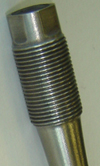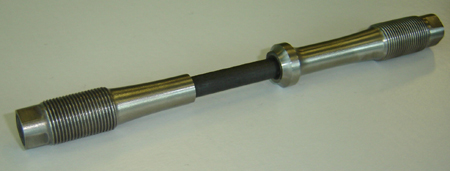Composite fasteners
 In a recent article, the subject of using fasteners for composite components was discussed. The number of components for which composites are considered is increasing considerably, and in some race series their use is limited by regulations.
In a recent article, the subject of using fasteners for composite components was discussed. The number of components for which composites are considered is increasing considerably, and in some race series their use is limited by regulations.
There are many areas in a Formula One engine, for example, where composites are expressly forbidden, but in production-based series, people are free to use composite components much more freely and so they have developed techniques to make their use economical. As with any new technology, the early adopters have to spend large sums for questionable gains, but as the new technique or product is taken up by a wider audience, the price drops and it becomes more affordable.
One British company looked into producing fasteners from composite materials a few years ago, initially for the Formula One market. As we might expect, this new technology was crushed from on high, but it is worth examining the technical pros and cons of these products.
In terms of looking at the physical parts, the threaded portion of the fastener was, as we might reasonably predict, made from metal, while the shank of the fastener was made from a composite. One of the composite fasteners is shown in the photo here. The term 'composite' can be applied to this component on two levels - not only is the shank made from a composite material itself (carbon-fibre reinforced plastic) but the fastener as a whole is made from more than one material.
One technical difficulty is in attaching the metallic threaded portions of the fastener to the composite shank. Such fasteners are expected to bear heavy loads and to cope, in many cases, with a significant cyclic load as well.
As can be seen from the photo, the plain shank of the fastener is of a smaller diameter than the composite, which can be seen at the end of the threaded portion. We can discern from this photo that the composite shank spreads to form a wedge within the threaded ends, thereby eliminating any adhesive bond to perform secondary functions such as preventing the shank from rotating, although it is likely that this is also not left to the integrity of the bond between the ends and the shank alone. In the case of the fastener shown, the ends are made from titanium, but the technique clearly allows the use of any material for this purpose.

So what advantages might a composite shank confer on a fastener? As we have seen from previous articles, it is likely that we want a combination of properties that include high strength and low modulus. The first dictates to a large extent the durability of the part, while the second helps to limit the proportion of the cyclic load in the joint which the fastener must be designed to cope with.
Looking at the properties for a typical fibre used in carbon-fibre reinforced polymer (CFRP) pre-preg (carbon fibres pre-impregnated with resin), which would be indicative of the material used for this application, we can see that a tensile strength of 4800 MPa (700 ksi) is typical, combined with a modulus of about 240 GPa (35 Msi). If we assume that the volume fraction of polymer used is sufficient to reduce the strength to 2400 MPa (50% volume fraction of fibre is typical for pultruded forms), then by a simple scaling calculation the modulus of the composite would be 120 GPa. Pultrusion is a similar process to extrusion, except that it is impossible to extrude, or push, fibres without them becoming distorted, so fibre-reinforced composites need to be pulled to form a continuous section such as a rod with fibres running lengthways.
So, for a strength of 2400 MPa, in excess of the typical strength levels achieved in high-specification metallic fasteners, we achieve a modulus comparable to that of titanium. The composite shank in this example can therefore have a 17% lower cross-sectional area, in a material with a density of about 2g/cm3, roughly 75% lower than that of steel.
There is a wide range of fibres that offer a combination of properties which would prove more favourable for a fastener than those presented here. The development of a fastener with a CFRP shank will surely not remain repressed for very long, even if motorsport doesn't take advantage of it.
Fig. 1 - Experimental Formula One stud with CFRP shank and Ti threads (Courtesy of Crompton Technology)
Written by Wayne Ward